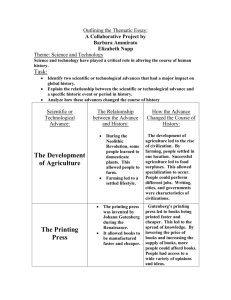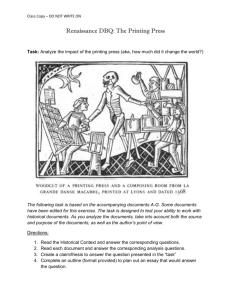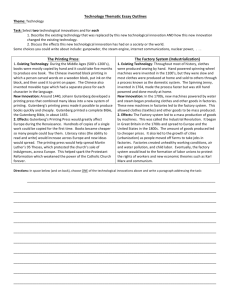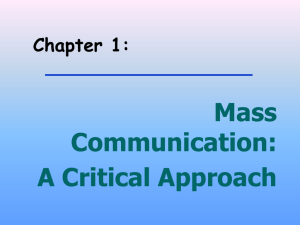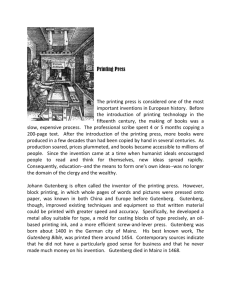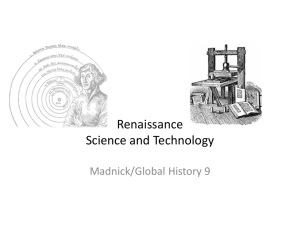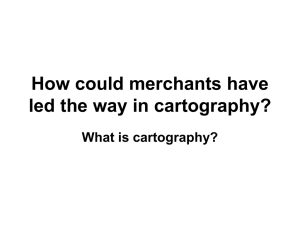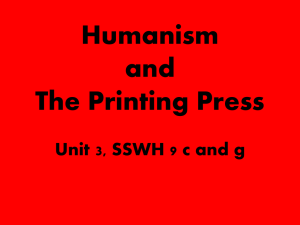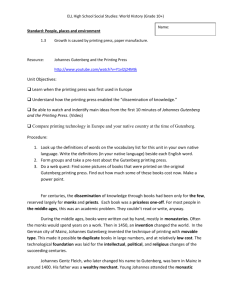Lecture Slides - Facultypages.morris.umn.edu
advertisement
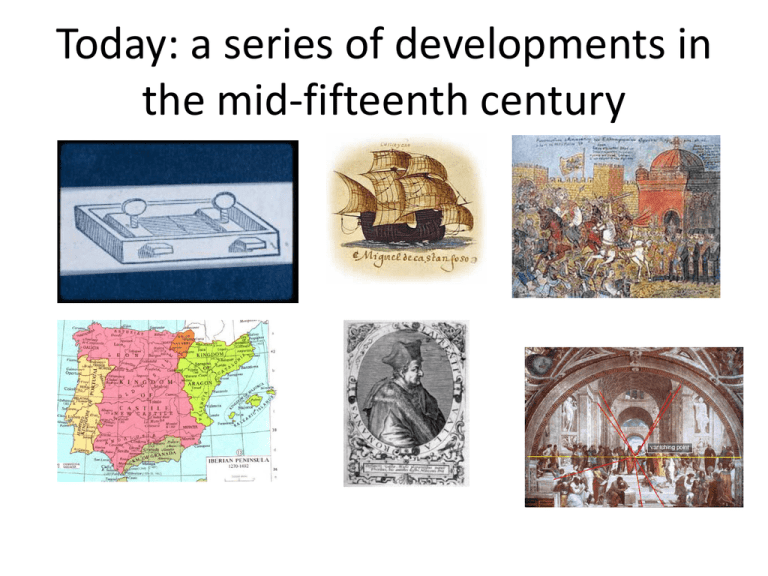
Today: a series of developments in the mid-fifteenth century Be thinking about. . . • To what extent was this event both rooted in local geographies and yet influential far beyond that space? Be thinking about. . . • To what extent was this event both rooted in local geographies and yet influential far beyond that space? • To what extent does this development reflect continuity with the past? Be thinking about. . . • To what extent was this event both rooted in local geographies and yet influential far beyond that space? • To what extent does this development reflect continuity with the past? • How feasible is it to separate political and religious factors in these circumstances? 1. The Emergence of Printing (c. 1450) Fust, Gutenberg, Schoeffer . . . Invention of movable type a process Pressure Frame First Printed Documents include: • • • • Poem on the Last Judgment Astronomical Calendar Papal indulgence for fighting the Turks Gutenberg bible “Gutenberg” Bible (c.1455) early print mimics manuscripts! Mainz Catholicon (1460) • “Printed without help of reed, stylus or pen but by the marvelous concord, proportion and harmony of punches and types. . . “ Printing 1450 - 1500 • By the beginning of the sixteenth century, more than 6 million books had been printed, with the average edition running between 200 to 1,000 copies. • In 1500, about 35,000 books were published each year in Europe, and a century later the number had jumped to between 150,000 and 200,000 books. Pope Alexander VI (1501): “The art of printing is very useful insofar as it furthers the circulation of useful and tested books; but it can be very harmful if it is permitted to widen the influence of pernicious works. It will therefore be necessary to maintain full control over the printers so that they may be prevented from bringing into print writings which are antagonistic to the Catholic faith or which are likely to cause trouble to believers.” What were the historical consequences of printing technology? • • • • • New pedagogical possibilities Expansion of literacy Standardization of languages Stimulated scholarship Enabled propaganda, etc. (Some criticized it as cheap and vulgar…) 2. Single-Point Perspective Filippo Brunelleschi’s innovation at the Baptistry (c.1424) 3. New critical perspectives on texts and history Lorenzo Valla (1406-1457) • How does one prove a forgery? Lorenzo Valla (1406-1457) • How does one prove a forgery? – Incorrect language and terminology – Errors of fact – Incompatible characters – Behavior anomalies – Lack of supporting evidence – Contradiction by historical records – Reason to suspect fraud – Etc. 4. The Fall of Constantinople (1453) 5. Portuguese Exploration (Henry the Navigator, 1395 – 1460) Consequences of Ottoman expansion for European trade? Portuguese exploration by 1500 The Slave Trade in Africa (Existing slave trade routes by 1400) Portuguese round the tip of Africa to meet up with eastern trade routes 6. 1469 marriage of Ferdinand of Aragon and Isabella of Castile 1478 founding of the Spanish Inquisition 1492 Muslim Granada falls and Jews expelled from Spain 1492 Ferdinand and Isabella send an Italian sailor to find a new route to India • Maps of Spanish exploration The Atlantic Trading Triangle Rethinking Late-Medieval Europe: Decline? Bridge? Transition? Recovery and reconnaissance?
